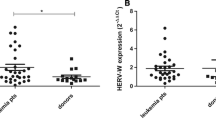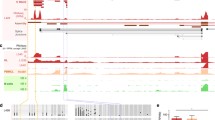Abstract
During the last decades, the prognosis for patients with Hodgkin Lymphoma (HL) has been steadily improved. Nevertheless, new and less toxic therapy strategies have to be developed especially for patients with advanced disease. The activation of human endogenous retroviruses (HERV) is suspected to occur in HL and therefore, HERV might represent interesting target structures. In order to identify transcribed HERV of the HERV-H and HERV-K families in HL we used a reverse transcription-polymerase chain reaction based cloning approach. In addition to unspliced HERV-H and HERV-K transcripts, we detected spliced HERV-K transcripts that matched genomic sequences with the expected splicing-donor and splicing-acceptor sites. Of particular interest was the expression of HERV-K18 related transcripts at the CD48 locus. Our data indicate transcriptional activity of several HERV loci in HL cells.






Similar content being viewed by others
References
Lander ES, Linton LM, Birren B et al (2001) Initial sequencing and analysis of the human genome. Nature 409:860–921
Boller K, König H, Sauter M, Mueller-Lantzsch N, Löwer R, Löwer J, Kurth R (1993) Evidence that HERV-K is the endogenous retrovirus sequence that codes for the human teratocarcinoma-derived retrovirus HTDV. Virology 196:349–353
Nelson PN (1995) Retroviruses in rheumatic diseases. Ann Rheum Dis 54:441–442
Nelson PN, Lever AM, Smith S, Pitman R, Murray P, Perera SA, Westwood OM, Hay FC, Ejtehadi HD, Booth JC (1999) Molecular investigations implicate human endogenous retroviruses as mediators of anti-retroviral antibodies in autoimmune rheumatic disease. Immunol Invest 28:277–289
Balada E, Vilardell-Tarres M, Ordi-Ros J (2010) Implication of human endogenous retroviruses in the development of autoimmune diseases. Int Rev Immunol 29:351–370
Grandi N, Tramontano E (2018) HERV envelope proteins: physiological role and pathogenic potential in cancer and autoimmunity. Front Microbiol 14:9:462
Küry P, Nath A, Créange A, Dolei A, Marche P, Gold J, Giovannoni G, Hartung HP, Perron H (2018) Human endogenous retroviruses in neurological diseases. Trends Mol Med 24:379–394
Lamprecht B, Walter K, Kreher S, Kumar R, Hummel M, Lenze D, Köchert K, Bouhlel MA, Richter J, Soler E, Stadhouders R, Jöhrens K, Wurster KD, Callen DF, Harte MF, Giefing M, Barlow R, Stein H, Anagnostopoulos I, Janz M, Cockerill PN, Siebert R, Dörken B, Bonifer C, Mathas S (2010) Derepression of an endogenous long terminal repeat activates the CSF1R proto-oncogene in human lymphoma. Nat Med 16:571–579
Thrift AP, Chiao EY (2018) Are non-HIV malignancies increased in the HIV-infected population? Curr Infect Dis Rep 20:22
Kowalkowski MA, Mims MA, Day RS, Du XL, Chan W, Chiao EY (2014) Longer duration of combination antiretroviral therapy reduces the risk of Hodgkin lymphoma: a cohort study of HIV-infected male veterans. Cancer Epidemiol 38:386–392
Contreras-Galindo R, Kaplan MH, Leissner P, Verjat T, Ferlenghi I, Bagnoli F, Giusti F, Dosik MH, Hayes DF, Gitlin SD, Markovitz DM (2008) Human endogenous retrovirus-K (HML-2) elements in the plasma of people with lymphoma and breast cancer. J Virol 82:9329–9336
Kewitz S, Staege MS (2013) Expression and regulation of the endogenous retrovirus 3 in Hodgkin’s lymphoma cells. Front Oncol 3:179
Kruse K, Nettling M, Wappler N, Emmer A, Kornhuber M, Staege MS, Grosse I (2018) WebHERV: A web server for the computational investigation of gene expression associated with endogenous retrovirus-like sequences. Front Microbiol 9:2384
Staege MS, Müller K, Kewitz S, Volkmer I, Mauz-Körholz C, Bernig T, Körholz D (2014) Expression of dual-specificity phosphatase 5 pseudogene 1 (DUSP5P1) in tumor cells. PLoS One 9:e89577
Malik HS, Henikoff S, Eickbush TH (2000) Poised for contagion: evolutionary origins of the infectious abilities of invertebrate retroviruses. Genome Res 10:1307–1318
Kim FJ, Manel N, Battini JL, Sitbon M (2004) La capture d’enveloppe par les retrovirus. Med Sci (Paris) 20:876–881
Perron H, Jouvin-Marche E, Michel M, Ounanian-Paraz A, Camelo S, Dumon A, Jolivet-Reynaud C, Marcel F, Souillet Y, Borel E, Gebuhrer L, Santoro L, Marcel S, Seigneurin JM, Marche PN, Lafon M (2001) Multiple sclerosis retrovirus particles and recombinant envelope trigger an abnormal immune response in vitro, by inducing polyclonal Vbeta16 T-lymphocyte activation. Virology 287:321–3032
Smit AF (1993) Identification of a new, abundant superfamily of mammalian LTR-transposons. Nucleic Acids Res 21:1863–1872
Meylan F, De Smedt M, Leclercq G, Plum J, Leupin O, Marguerat S, Conrad B (2005) Negative thymocyte selection to HERV-K18 superantigens in humans. Blood 105:4377–4382
Herve CA, Lugli EB, Brand A, Griffiths DJ, Venables PJ (2002) Autoantibodies to human endogenous retrovirus-K are frequently detected in health and disease and react with multiple epitopes. Clin Exp Immunol 128:75–82
Avrameas S, Selmi C (2013) Natural autoantibodies in the physiology and pathophysiology of the immune system. J Autoimmun 41:46–49
Staege MS (2015) A multi-component model of Hodgkin’s Lymphoma. PLoS ONE 10:e0124614
Shin W, Lee J, Son SY, Ahn K, Kim HS, Han K (2013) Human-specific HERV-K insertion causes genomic variations in the human genome. PLoS ONE 8:e60605
Wildschutte JH, Williams ZH, Montesion M, Subramanian RP, Kidd JM, Coffin JM (2016) Discovery of unfixed endogenous retrovirus insertions in diverse human populations. Proc Natl Acad Sci USA 113:E2326–E2334
Thomas J, Perron H, Feschotte C (2018) Variation in proviral content among human genomes mediated by LTR recombination. Mob DNA 9:36
Mager DL, Wilkinson DA (1995) A PCR strategy to identify coding competent human endogenous retroviruses. In: Becker Y, Darai G (eds) PCR: protocols for diagnosis of human and animal virus diseases. Springer, Berlin, pp 45–49
Gemmell P, Hein J, Katzourakis A (2016) Phylogenetic analysis reveals that ERVs “die young” but HERV-H is unusually conserved. PLoS Comput Biol 12:e1004964
Downey RF, Sullivan FJ, Wang-Johanning F, Ambs S, Giles FJ, Glynn SA (2015) Human endogenous retrovirus K and cancer: Innocent bystander or tumorigenic accomplice? Int J Cancer 137:1249–1257
Drexler HG, Gaedicke G, Lok MS, Diehl V, Minowada J (1986) Hodgkin’s disease derived cell lines HDLM-2 and L-428: Comparison of morphology, immunological and isoenzyme profiles. Leukemia Res 10:487–500
Wolf J, Kapp U, Bohlen H, Kornacker M, Schoch C, Stahl B, Mücke S, von Kalle C, Fonatsch C, Schaefer HE, Hansmann ML, Diehl V (1996) Peripheral blood mononuclear cells of a patient with advanced Hodgkin’s lymphoma give rise to permanently growing Hodgkin–Reed Sternberg cells. Blood 87:3418–3428
Kamesaki H, Fukuhara S, Tatsumi E, Uchino H, Yamabe H, Miwa H, Shirakawa S, Hatanaka M, Honjo T (1986) Cytochemical, immunologic, chromosomal, and molecular genetic analysis of a novel cell line derived from Hodgkin’s disease. Blood 68:285–292
Mueller T, Hantsch C, Volkmer I, Staege MS (2018) Differentiation-dependent regulation of human endogenous retrovirus K sequences and neighbouring genes in germ cell tumour cells. Front Microbiol 9:1253
Wang X, Spandidos A, Wang H, Seed B (2012) PrimerBank: a PCR primer database for quantitative gene expression analysis, 2012 update. Nucleic Acids Res 40(Database issue):D1144–D1149
Altschul SF, Gish W, Miller W, Myers EW, Lipman DJ (1990) Basic local alignment search tool. J Mol Biol 215:403–410
Desmet FO, Hamroun D, Lalande M, Collod-Béroud G, Claustres M, Béroud C (2009) Human Splicing Finder: an online bioinformatics tool to predict splicing signals. Nucleic Acids Res 37:e67
The UniProt Consortium (2017) UniProt: the universal protein knowledgebase. Nucleic Acids Res 45:D158–D169
Livak KJ, Schmittgen TD (2001) Analysis of relative gene expression data using real-time quantitative PCR and the 2(−Delta Delta C(T)) method. Methods 25:402–408
Foell JL, Volkmer I, Giersberg C, Kornhuber M, Horneff G, Staege MS (2008) Loss of detectability of Charcot-Leyden crystal protein transcripts in blood cells after treatment with dimethyl sulfoxide. J Immunol Methods 339:99–103
Mayer J, Blomberg J, Seal R (2011) A revised nomenclature for transcribed human endogenous retroviral loci. Mobile DNA 2:7
McArdel SL, Terhorst C, Sharpe AH (2016) Roles of CD48 in regulating immunity and tolerance. Clin Immunol 164:10–20
Thorley-Lawson DA, Schooley RT, Bhan AK, Nadler LM (1982) Epstein–Barr virus superinduces a new human B cell differentiation antigen (B-LAST-1) expressed on transformed lymphoblasts. Cell 30:415–425
Sutkowski N, Palkama T, Ciurli C, Sekaly RP, Thorley-Lawson DA, Huber BT (1996) An Epstein–Barr virus-associated superantigen. J Exp Med 184:971–980
Sutkowski N, Conrad B, Thorley-Lawson DA, Huber BT (2001) Epstein–Barr virus transactivates the human endogenous retrovirus HERV-K18 that encodes a superantigen. Immunity 15:579–589
Poppema S (1996) Immunology of Hodgkin’s disease. Baillieres Clin Haematol 9:447–457
Poppema S, Lai R, Visser L, Yan XJ (1996) CD45 (leucocyte common antigen) expression in T and B lymphocyte subsets. Leuk Lymphoma 20:217–222
Roers A, Montesinos-Rongen M, Hansmann ML, Rajewsky K, Küppers R (1998) Amplification of TCRβ gene rearrangements from micromanipulated single cells: T cells rosetting around Hodgkin and Reed-Sternberg cells in Hodgkin’s disease are polyclonal. Eur J Immunol 28:2424–2431
Willenbrock K, Roers A, Blöhbaum B, Rajewsky K, Hansmann ML (2000) CD8(+) T cells in Hodgkin’s disease tumor tissue are a polyclonal population with limited clonal expansion but little evidence of selection by antigen. Am J Pathol 157:171–175
Steidl C, Diepstra A, Lee T, Chan FC, Farinha P, Tan K, Telenius A, Barclay L, Shah SP, Connors JM, van den Berg A, Gascoyne RD (2012) Gene expression profiling of microdissected Hodgkin Reed-Sternberg cells correlates with treatment outcome in classical Hodgkin Lymphoma. Blood 120:3530–3540
Acknowledgements
We thank Ines Volkmer for technical assistance and Dixie Mager for helpful advice.
Author information
Authors and Affiliations
Contributions
MB, VC and HC performed experiments, MSS designed the study, all authors analyzed the data and wrote the paper.
Corresponding author
Ethics declarations
Conflict of interest
The authors report no conflicts of interest in this work.
Additional information
Publisher’s Note
Springer Nature remains neutral with regard to jurisdictional claims in published maps and institutional affiliations.
Rights and permissions
About this article
Cite this article
Barth, M., Gröger, V., Cynis, H. et al. Identification of human endogenous retrovirus transcripts in Hodgkin Lymphoma cells. Mol Biol Rep 46, 1885–1893 (2019). https://doi.org/10.1007/s11033-019-04640-x
Received:
Accepted:
Published:
Issue Date:
DOI: https://doi.org/10.1007/s11033-019-04640-x




